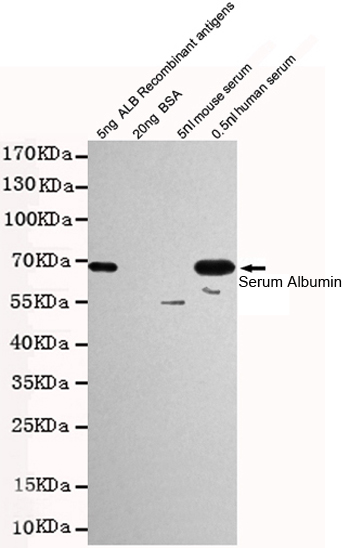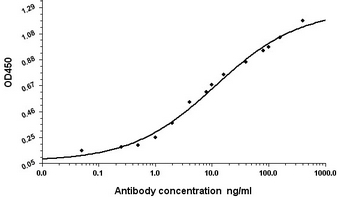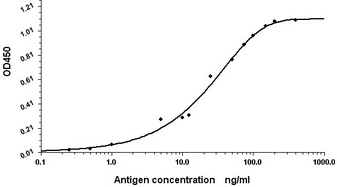Human Serum Albumin mouse mAb
- Catalog No.:YM1255
- Applications:WB;ELISA;sELISA
- Reactivity:Human
- Target:
- Albumin
- Fields:
- >>Thyroid hormone synthesis
- Gene Name:
- alb
- Human Gene Id:
- 213
- Human Swiss Prot No:
- P02768
- Mouse Swiss Prot No:
- P07724
- Immunogen:
- Purified Human serum albumin.
- Specificity:
- This antibody detects endogenous levels of Serum Albumin and does not cross-react with related proteins.
- Formulation:
- Liquid in PBS containing 50% glycerol, 0.5% BSA and 0.02% sodium azide.
- Source:
- Monoclonal, Mouse
- Dilution:
- wb 1:1000
- Purification:
- The antibody was affinity-purified from mouse ascites by affinity-chromatography using epitope-specific immunogen.
- Concentration:
- 1 mg/ml
- Storage Stability:
- -15°C to -25°C/1 year(Do not lower than -25°C)
- Other Name:
- ALB;ALBU_HUMAN;Albumin (32 AA);Albumin (AA 34);Albumin;Analbuminemia;Bisalbuminemia;Cell growth inhibiting protein 42;DKFZp779N1935;Dysalbuminemic hyperthyroxinemia;Growth inhibiting protein 20;HSA;Hyperthyroxinemia dysalbuminemic;PRO0883;PRO0903;PRO1341;PRO2044;PRO2619;Serum albumin.
- Observed Band(KD):
- 67kD
- Background:
- This gene encodes the most abundant protein in human blood. This protein functions in the regulation of blood plasma colloid osmotic pressure and acts as a carrier protein for a wide range of endogenous molecules including hormones, fatty acids, and metabolites, as well as exogenous drugs. Additionally, this protein exhibits an esterase-like activity with broad substrate specificity. The encoded preproprotein is proteolytically processed to generate the mature protein. A peptide derived from this protein, EPI-X4, is an endogenous inhibitor of the CXCR4 chemokine receptor. [provided by RefSeq, Jul 2016],
- Function:
- caution:A peptide arising from positions 166 to 174 was originally (PubMed:3087352 and PubMed:2437111) termed neurotensin-related peptide (NRP) or kinetensin and was thought to regulates fat digestion, lipid absorption, and blood flow.,disease:A variant structure of albumin could lead to increased binding of zinc resulting in an asymptomatic augmentation of zinc concentration in the blood [MIM:194470].,disease:Defects in ALB are a cause of familial dysalbuminemic hyperthyroxinemia (FDH) [MIM:103600]. FDH is a form of euthyroid hyperthyroxinemia that is due to increased affinity of ALB for T(4). It is the most common cause of inherited euthyroid hyperthyroxinemia in Caucasian population.,function:Serum albumin, the main protein of plasma, has a good binding capacity for water, Ca(2+), Na(+), K(+), fatty acids, hormones, bilirubin and drugs. Its main function is the regulation of the collo
- Subcellular Location:
- Secreted.
- Expression:
- Plasma.
- June 19-2018
- WESTERN IMMUNOBLOTTING PROTOCOL
- June 19-2018
- IMMUNOHISTOCHEMISTRY-PARAFFIN PROTOCOL
- June 19-2018
- IMMUNOFLUORESCENCE PROTOCOL
- September 08-2020
- FLOW-CYTOMEYRT-PROTOCOL
- May 20-2022
- Cell-Based ELISA│解您多样本WB检测之困扰
- July 13-2018
- CELL-BASED-ELISA-PROTOCOL-FOR-ACETYL-PROTEIN
- July 13-2018
- CELL-BASED-ELISA-PROTOCOL-FOR-PHOSPHO-PROTEIN
- July 13-2018
- Antibody-FAQs
- Products Images

- Western blot detection of Human Serum Albumin in 0.5nl human serum and 5ng ALB Recombinant antigens cell lysates using Human Serum Albumin mouse mAb (1:1000 diluted).Predicted band size:67KDa.Observed band size:67KDa.

- Indirect ELISA assay for anti-Human Serum Albumin mouse mAb.Antigen coating concentration: 8ug/ml.

- Standard Curve for Human Serum Albumin (Analyte: Human Serum Albumin protein ); using Capture Antibody Mouse monoclonal [1A8-C5-B4] to Human Serum Albumin at 8μg/ml and Detector Antibody Rabbit polyclonal antiserum to Human Serum Albumin.



